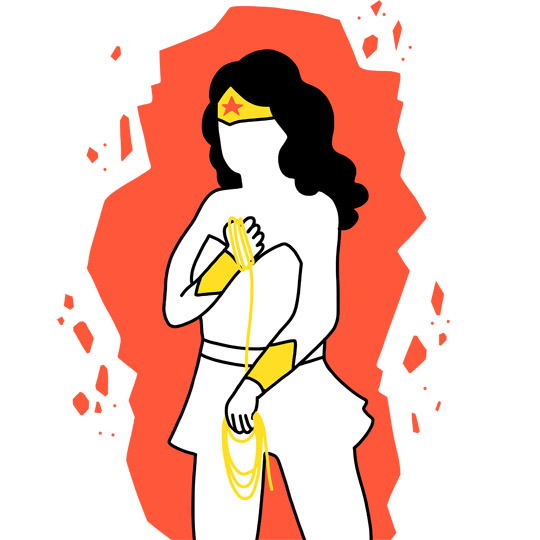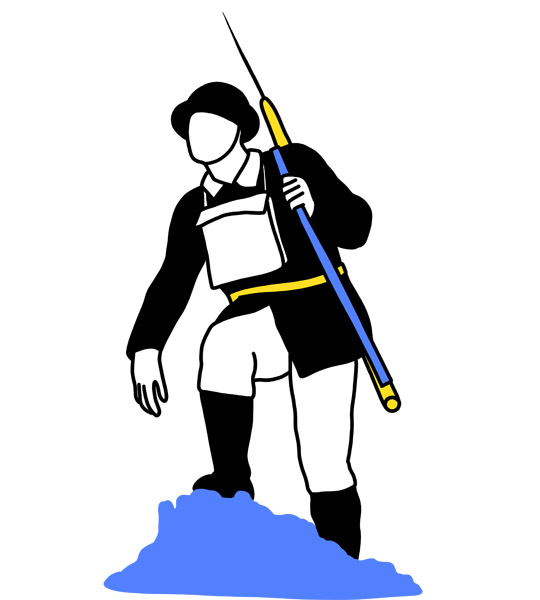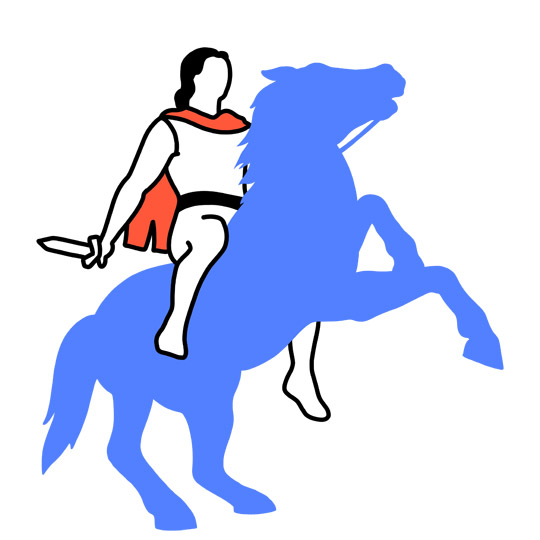Often copied but never matched
Freiburg, Nov 15, 2018
Noble warriors, cunning spies, sexy revenants – the new online encyclopedia “Compendium heroicum” gathers articles on the latest findings in the realm of hero research. The new digital reference book is for anyone who wants to know more about heroes and heroines. What raises a figure to hero status? What types arise in any given era – from the noble heroes of Greek mythology to the vegetarian vampires of recent cinema? And how do societies create their heroes? Because one thing’s for sure: they need each other. “Heroes always need an audience which honors and thinks of them,” says Georg Feitscher, who is responsible for the Compendium. “And at the same time, the society benefits from the figures it anoits as its heroes.” History has produced countless figures who are celebrated and honored, says Feitscher. “But what interests us are the processes by which heroes are created.” With these varying conditions as a starting-point, the researchers in the Freiburg collaborative research center “Heroes – Heroizations – Heroisms” are sorting heroes into five types. What are the characteristics that societies ascribe to their heroes?
 Don’t try to lie - Wonder Woman catches the truth with her lasso.
Don’t try to lie - Wonder Woman catches the truth with her lasso.
Illustration: Svenja Kirsch
Extraordinary - No lies in the lasso of truth
Becoming a hero starts with the drawing of a border. On the one side is the dull mediocrity of intelligence, good looks and strength. “On the other side is the hero who has made a remarkable achievement and is therefore different from all the others,” Feitscher explains. This extraordinariness is found even in the oldest stories told: The heroes of Greek mythology – half-god, half-human – fought, founded cities and brought high culture to the people. And today’s equivalent? “They are for example the superheroes, who obtain superhuman qualities using magic, prostheses or drugs.” Here comes Wonder Woman from US publishers DC Comics. Princess Diana leaves her paradise island to sort out that no-good god of war. This true amazon doesn’t just rely on her training in hand-to-hand combat. She encircles her opponent with a lasso which forces him to tell the truth; her metal vambraces deflect every bullet. And then there is the godsbane, a magic sword. The world is saved. And, as if that weren’t enough – there’s not a hair out of place even after the toughest fight.
 The pilot Chesley B. Sullenberger was celebrated in the US as “the hero of the Hudson.”
The pilot Chesley B. Sullenberger was celebrated in the US as “the hero of the Hudson.”
Illustration: Svenja Kirsch
Extraterritorial - Going where they’re not supposed to
“We’re gonna be in the Hudson.” The pilot’s voice is calm and resolute. The air traffic controller who gets this message can’t believe his ears. Surely not even a madman would try to land his damaged plane on the Hudson River... But that’s exactly what Chesley B. Sullenberger, better known as Sully, does one January morning in 2009. Everyone on board survives the emergency landing. The media celebrate Sully as the Hero of the Hudson; New York’s mayor calls him “Captain Cool,” and the newly-inaugurated President Barack Obama pays tribute to him. But it could have turned out quite differently. “Heroic deeds are usually linked to a breach of previous norms. Somebody does something one doesn’t or shouldn’t do,” says Feitscher. The community first has to agree on how to judge that action. This tipping-point was something Sullenberger felt keenly. He was investigated for 18 months in order to establish whether he had unnecessarily risked the lives of 155 people. “That kind of overstepping the boundaries is extremely polarizing; and if the plane had crashed, his decision would have be judged very differently. The question is – which group’s interpretation comes out on top?” In Sully’s case, it was his admirers. And the pilot was able to cash in on his image. His book is called “Highest Duty: My Search for What Really Matters.”
 A moral compass for future generations: Nearly every European country built a memorial for the Unknown Soldier.
A moral compass for future generations: Nearly every European country built a memorial for the Unknown Soldier.
Illustration: Svenja Kirsch
Exemplary - The cult of nameless warriors
It’s an understatement to call heroes role models. They have to be a lot more than that, Feitscher says. “They are a projection of all a society’s desires and expectations.” What the society can’t do for itself – its heroes must do,” he adds. Who ends up paying for ideals which have gone too far? Soldiers, who do not fear the barrage as they wait in their trenches. Even better – a whole army of soldiers. That notion of a heroic collective arose in the 19th century. “Before that there were great generals, who won battles with special deeds.” But with the rise of the bourgeoisie, the individual came into focus. The veneration of soldiers reaches its climax in World War I – “Endurance, fortitude, a willingness to sacrifice themselves – these values were projected onto the soldiers, regardless of whether the individual was able to uphold them or not.” The cult went as far as to put up monuments to the Unknown Soldier. Nearly every European country erected such a monument, to be a moral compass for all time and to remind later generations how they should behave at the front. “It is an unsolveable dichotomy,” Feitscher explains. “A society cheers on a hero as incomparable – and yet calls on all the others to follow his example.”
 Achilles fights Hector - possibly the greatest showdown in the history of literature.
Achilles fights Hector - possibly the greatest showdown in the history of literature.
Illustration: Svenja Kirsch
Audacious - Never fear!
It may be the greatest showdown in the history of literature. In the one corner: Hector, darling of the gods and the Trojan’s bravest warrior. In the other corner, or rather tent: Achilles, the strongest and most feared Greek warrior – who has a score to settle with Hector, and has trouble controlling his temper. Behind the gates of Troy, the audience is roaring, and when the lance and spear come out, there will be blood. “It is a classic characteristic ascribed to heroes for thousands of years,” Feitscher reports. “They have to fight, measure their strength against the others; they often suffer and sometimes die.” They are heroes because of their determination to sacrifice their lives for an ideal, a country or a religion. And a good story about a fight needs at least two characters – the hero and his adversary. And it is all too human to think in such opposites. “In this narrative we intuitively see our own story, and have done in every age.”

The equestrian: Alexander the Great was considered the epitome of a determined conqueror.
Illustration: Svenja Kirsch
Overwhelming - Single-handed conquest of the world
“Then there’s one who gets all of the attention” says Feitscher of the fifth and final category. “Stories about heroes are always told a certain way. Every important piece of action, decision or development is focused on one character – everything else fades into the background.” Whether it’s Christopher Columbus, Galileo Galilei or Napoleon Bonaparte: One important man after another seems to have revolutionized the world single-handedly. Alexander the Great, for example, is seen as the epitome of a determined conqueror. The King of Macedonia marched his army from Greece, via Turkey, across the Near East and Persia, all the way to India. “That was only possible on the basis of an enormous, complex administration – but no-one wants to hear about the logistics behind the campaigns.” History, Feitscher says, is complex and hard to see clearly. Many important figures, institutions and inventions which were sometimes vital to success were left out of the story to make it easily understandable. “And the greater the historical distance, the more history becomes focused on a single figure – a hero.”
Rimma Gerenstein
Compendium heroicum
The collaborative research center “Heroes – Heroizations – Heroisms” and the Free University of Berlin’s project, Open Encyclopedia System (OES), have jointly started the online encyclopedia “Compendium heroicum” – an open digital platform which enables direct access to the centralised results of hero research. The encyclopedia is based on open-source software and publishes its content under an open access license; its contents are divided into five areas, each of which is dedicated to a different aspect of the heroic. “Hero types” presents heroic figures and models of heroic actions; “Cultures and Practises” shines a light on communities and their heroes in a historical context. “Objects and Attributes” shows the materiality and symbolism of the heroic, “Theory of the Heroic” presents underlying approaches and concepts, and “Mediality” is dedicated to the issue of aesthetics and story patterns. The entries are written by the collaborative research center members as well as guest authors from various humanities disciplines.
www.compendium-heroicum.de

